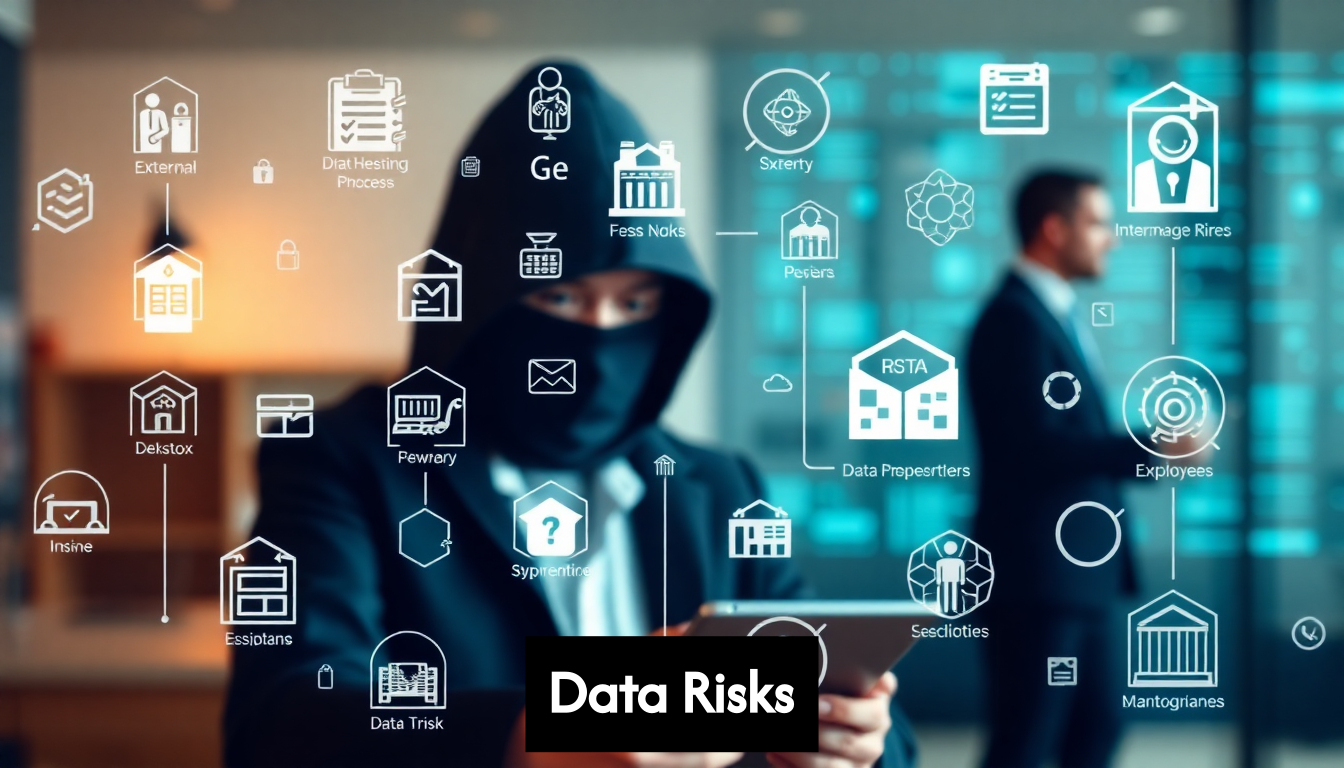
The risks of compromised sensitive data are more serious than you might think. Recent studies show that a data breach can cost an organisation an average of £3 million. But here’s the kicker: it’s not just about the money. The true impact stretches far beyond immediate financial losses. Because understanding how to secure sensitive data effectively can mean the difference between survival and catastrophe for a business.
Understanding Data Sensitivity Risks
Every organisation handles data that, if compromised, could have serious consequences for both the business and its customers. Understanding the risks associated with sensitive data is the foundation of effective security. But what exactly makes data ‘sensitive’, and how can we accurately assess the risks it faces?
What Constitutes Sensitive Data
Sensitive data encompasses any information that requires protection from unauthorised access. This typically includes personally identifiable information (PII) such as names, addresses, and identification numbers; financial details like bank account information and credit card numbers; health records protected under regulations like GDPR or HIPAA; intellectual property; and business-critical information such as strategic plans or pricing models.
The sensitivity of data often varies by context. For example, a customer’s email address might be relatively low-risk when stored in an isolated system but becomes highly sensitive when linked to purchase history or health information. This contextual nature of data sensitivity means organisations must consider not just individual data elements, but how they interconnect.
Assessing Data Sensitivity Levels
According to research on privacy risk perception, three key factors influence the sensitivity level of data:
- Data visibility – How accessible the data is to various parties within and outside the organisation
- Data sensitivity – The inherent nature of the information and potential for harm if exposed
- Data relevance – How necessary the data is for the organisation’s legitimate purposes
Interestingly, this research found that visibility had the highest impact on perceived privacy risk, with users particularly concerned about data that becomes visible by default or upon disclosure without explicit consent.
Common Risks to Sensitive Data

Sensitive data faces numerous threats that organisations must prepare for:
External Threats include cybercriminals conducting targeted attacks, data breaches through vulnerabilities, and sophisticated social engineering attacks targeting employees with access to sensitive information.
Internal Risks are equally concerning, encompassing accidental data exposure by well-meaning employees, privilege abuse by staff with excessive access rights, and malicious insiders deliberately extracting valuable information.
Systemic Vulnerabilities present a broader challenge, including inadequate access controls, poor data management practices, and insufficient encryption of data both in transit and at rest.
The Consequences of Data Exposure
The impact of sensitive data exposure extends far beyond immediate financial losses. Organisations face regulatory penalties under frameworks like GDPR, which can reach up to 4% of global annual turnover. Reputational damage often proves even more costly in the long term, eroding customer trust and loyalty.
For individuals whose data is compromised, the consequences can be devastating, ranging from identity theft and financial fraud to personal safety risks if location data or personal details fall into the wrong hands.
Understanding these risks forms the critical first step in developing a comprehensive strategy for how to secure sensitive data effectively. By recognising what constitutes sensitive information in your specific context and the particular threats it faces, you can begin building appropriate protective measures that balance security with operational functionality.
Key Takeaways
| Takeaway | Explanation |
|---|---|
| Understand Data Sensitivity | Recognise what constitutes sensitive data within your organisation, including PII, financial details, and intellectual property, and assess risks accordingly. |
| Implement Strong Encryption | Adopt robust encryption methods such as symmetric or asymmetric encryption to protect data both in transit and at rest, backed by effective key management practices. |
| Establish Strict Access Controls | Apply the principle of least privilege to restrict user access to sensitive data, utilise Role-Based Access Control (RBAC), and enforce Multi-Factor Authentication (MFA) to enhance security. |
| Conduct Regular Security Audits | Regularly schedule security audits, including vulnerability assessments and compliance checks, to identify weaknesses and ensure adherence to security policies and regulations. |
| Continuous Monitoring and Review | Maintain ongoing vigilance by regularly reviewing access permissions, monitoring for unusual activity, and ensuring remediation of identified security issues. |
Adopting Strong Encryption Methods
Encryption serves as the bedrock of data security, transforming readable data into coded text that remains unintelligible without the proper decryption key. When implementing strategies on how to secure sensitive data, adopting robust encryption methods should be a top priority for any organisation handling confidential information.
Understanding Encryption Fundamentals
At its core, encryption involves converting plaintext (readable data) into ciphertext (encoded data) using mathematical algorithms and encryption keys. This process renders the information unreadable to unauthorised users, even if they manage to access the encrypted files. Only those possessing the correct decryption keys can transform the ciphertext back into understandable information.
According to research published in the International Journal of Advanced Research in Science, Communication and Technology, the growing threats to data privacy and security have significantly increased the importance of encryption in protecting digital information. With cyber threats evolving rapidly, organisations must understand and implement appropriate encryption methods based on their specific security requirements.
Choosing Between Symmetric and Asymmetric Encryption
When planning how to protect sensitive data, one crucial decision involves selecting between symmetric and asymmetric encryption approaches:
Symmetric Encryption uses the same key for both encryption and decryption processes. Popular algorithms include AES (Advanced Encryption Standard), Triple DES, and Blowcrypt. Symmetric encryption offers advantages including:
- Faster processing speeds, making it suitable for encrypting large volumes of data
- Lower computational resource requirements
- Simpler implementation for internal systems
However, its primary challenge lies in secure key distribution—how do you safely share the encryption key with authorised parties?
Asymmetric Encryption utilises a pair of mathematically related keys: a public key for encryption and a private key for decryption. Common examples include RSA, ECC (Elliptic Curve Cryptography), and Diffie-Hellman. This approach offers:
- Enhanced security for transmitting information between parties
- Elimination of the key distribution problem
- Digital signature capabilities for authentication
The trade-off comes with higher computational demands and slower processing compared to symmetric encryption.
Encryption Best Practices
To effectively secure sensitive data through encryption, implement these proven practices:
-
Encrypt data both in transit and at rest: Ensure information is protected whether it’s being transmitted across networks or stored in databases and file systems.
-
Implement proper key management: Establish procedures for secure key generation, storage, distribution, rotation, and revocation. Remember that encryption is only as strong as your key management practices.
-
Use industry-standard algorithms: Avoid proprietary or obscure encryption methods. Instead, rely on well-established, publicly scrutinised algorithms that have withstood extensive testing.
-
Apply encryption selectively: While encrypting all data might seem ideal, it can impact system performance. Prioritise sensitive data based on classification levels, ensuring critical information receives appropriate protection.
Overcoming Common Encryption Challenges
While encryption provides robust protection, organisations often face implementation challenges. Performance concerns frequently arise, as encryption and decryption processes demand computational resources that might affect system responsiveness. Address this by optimising encryption deployment—focus on truly sensitive data rather than encrypting everything indiscriminately.
Key management represents another significant hurdle. Losing encryption keys means permanently losing access to encrypted data. Mitigate this risk through comprehensive key management systems with appropriate backup and recovery mechanisms.
Finally, consider user experience implications. Overly complex encryption implementations might drive users toward insecure workarounds. Balance security requirements with usability to encourage adoption of secure practices throughout your organisation.
By thoughtfully implementing strong encryption methods, organisations can significantly enhance how they secure sensitive data, protecting it from both external threats and internal risks.
Implementing Strict Access Controls
Access control serves as a critical line of defence when learning how to secure sensitive data effectively. By determining who can view, modify, or delete information, robust access controls ensure that only authorised individuals interact with protected resources in appropriate ways.
The Principle of Least Privilege
At the foundation of effective access control lies the principle of least privilege (PoLP). This fundamental security concept dictates that users should receive only the minimum permissions necessary to perform their job functions—nothing more. Implementing least privilege significantly reduces the attack surface by limiting what authorised users can access or modify.
Put simply, a marketing team member likely doesn’t need access to financial records, while accounting staff rarely require access to customer support tickets. By restricting permissions to what’s strictly necessary, organisations can prevent accidental data exposure and limit the potential damage from compromised accounts.
Adopting least privilege requires:
- Regular review of existing access permissions
- Clear documentation of required access for each role
- Prompt revocation of unnecessary privileges
- Temporary elevation of privileges when needed (rather than permanent excessive access)
Role-Based Access Control Systems

Role-Based Access Control (RBAC) represents one of the most effective frameworks for implementing least privilege at scale. Rather than assigning permissions individually to each user, RBAC ties permissions to specific roles within the organisation. Users are then assigned to appropriate roles based on their responsibilities.
This approach offers several advantages for organisations seeking to protect sensitive data:
-
Simplified administration: When an employee changes positions, administrators simply assign the new role rather than reconfiguring individual permissions.
-
Consistent security: RBAC ensures all employees with similar responsibilities have identical access levels, reducing the risk of oversight.
-
Easier compliance: Well-defined roles with clear permission boundaries simplify audit processes and regulatory compliance reporting.
According to research on access control vulnerabilities, broken access control ranked as the #1 web application vulnerability in the OWASP Top 10 for 2021, highlighting how crucial proper implementation remains. The research notes that modern web application frameworks often lack native access control features, resulting in ad-hoc implementations that create security gaps.
Implementing Multi-Factor Authentication
Even with well-designed role-based permissions, password-only authentication creates significant vulnerabilities. Multi-factor authentication (MFA) strengthens access controls by requiring users to provide multiple forms of verification before gaining access to sensitive resources.
Typical MFA implementations combine:
- Something you know (password or PIN)
- Something you have (mobile device, security key, or token)
- Something you are (biometric data like fingerprints or facial recognition)
Requiring MFA for access to sensitive data adds a crucial layer of protection, even if credentials become compromised. For maximum effectiveness, mandate MFA for all administrator accounts, remote access, and any systems containing regulated or confidential information.
Creating Access Control Zones
Segmenting your network into distinct security zones with varying levels of access control creates multiple layers of protection for sensitive data. This approach compartmentalises information and systems based on sensitivity levels, ensuring that a breach in one area doesn’t automatically compromise everything.
Effective network segmentation includes:
- Secure data repositories with stringent access requirements for the most sensitive information
- Internal zones for general business data accessible to authenticated employees
- Demilitarised zones (DMZ) for public-facing resources
Implement proper network controls between zones, including firewalls, intrusion detection systems, and detailed logging of cross-zone access attempts.
Continuous Monitoring and Review
Access controls aren’t “set and forget” security measures. Maintaining their effectiveness requires ongoing vigilance through:
- Regular user access reviews to identify and remove unnecessary permissions
- Prompt deprovisioning when employees change roles or leave the organisation
- Automated monitoring for unusual access patterns or potential privilege abuse
- Periodic penetration testing to identify access control weaknesses
By implementing comprehensive access controls built on the principle of least privilege, organisations create a robust framework for how to secure sensitive data against both external attackers and internal threats.
Conducting Regular Security Audits
Security audits form an essential component of any comprehensive strategy on how to secure sensitive data. These structured evaluations help organisations identify vulnerabilities, assess compliance with security policies, and validate that protective measures function as intended. Without regular audits, security gaps can remain undetected until exploited by malicious actors.
The Critical Role of Security Audits
Security audits serve multiple crucial functions in protecting sensitive information. They provide an objective assessment of your current security posture, highlighting both strengths and weaknesses. This systematic approach to security evaluation enables organisations to:
- Identify vulnerabilities before they can be exploited
- Verify compliance with internal policies and external regulations
- Assess the effectiveness of existing security controls
- Document security measures for stakeholders and regulators
- Prioritise security investments based on actual risks rather than perceived threats
According to research on security policy audits, the security community often focuses heavily on software and hardware security while neglecting crucial policy and process evaluations. The researchers found that simple policy flaws, such as forgotten access controls on cloud storage, regularly expose private data affecting millions of users. These findings highlight why comprehensive security audits that examine both technical controls and policy implementation are essential.
Types of Security Audits for Data Protection
Organisations should implement several types of security audits to comprehensively protect sensitive data:
Vulnerability Assessments scan systems for known security weaknesses using automated tools. These assessments identify potential entry points for attackers, such as unpatched software, misconfigured systems, or weak passwords. While valuable for detecting technical vulnerabilities, they represent just one component of a complete security audit programme.
Penetration Testing takes vulnerability assessment further by actively attempting to exploit discovered weaknesses. Ethical hackers simulate real-world attacks to determine if vulnerabilities are exploitable and what impact a successful breach might have. This provides a realistic evaluation of your security defences under controlled conditions.
Compliance Audits verify adherence to relevant regulatory requirements such as GDPR, HIPAA, PCI DSS, or industry-specific standards. These structured evaluations examine whether your organisation meets the specific controls mandated by applicable regulations, helping you avoid costly penalties for non-compliance.
Policy and Procedure Reviews examine the organisation’s security documentation, ensuring policies are comprehensive, up-to-date, and properly implemented. This often-overlooked audit type helps identify gaps between documented security practices and actual implementation.
Establishing an Effective Audit Schedule
The frequency of security audits should reflect both the sensitivity of your data and the rate at which your technology environment changes. Consider this balanced approach:
- Automated vulnerability scans: Conduct monthly or even weekly for critical systems
- Comprehensive vulnerability assessments: Perform quarterly
- Penetration testing: Schedule annually or after significant infrastructure changes
- Compliance audits: Complete annually or as required by specific regulations
- Policy reviews: Conduct semi-annually and after major organisational changes
Supplemental audits should also follow significant events such as mergers, acquisitions, major system implementations, or substantial changes to business processes that involve sensitive data.
Maximising the Value of Security Audits
To derive maximum benefit from security audits when learning how to protect sensitive data, follow these best practices:
Engage independent auditors when possible. External perspectives often identify blind spots that internal teams miss. While some audits may be conducted internally, periodic third-party assessments provide valuable objectivity.
Document and track findings from each audit in a centralised system. This creates an audit trail showing how security issues are addressed over time and helps prevent the same vulnerabilities from recurring.
Prioritise remediation efforts based on risk levels. Not all findings require immediate action—focus first on vulnerabilities that pose the greatest risk to sensitive data.
Communicate results appropriately across the organisation. Executive summaries should reach leadership, while technical teams need detailed findings to implement corrections.
Close the loop by verifying that identified issues have been properly addressed. Follow-up testing confirms that remediation efforts effectively resolved the original vulnerabilities.
Regular, comprehensive security audits provide the visibility needed to maintain robust protection for sensitive data. By systematically evaluating security controls, organisations can identify and address vulnerabilities before they lead to data breaches, ensuring that protective measures remain effective against evolving threats.
Frequently Asked Questions
What is considered sensitive data?
Sensitive data refers to any information that requires protection from unauthorised access, including personally identifiable information (PII), financial details, health records, and intellectual property.
How can I assess the sensitivity of my organisation’s data?
Assess the sensitivity of data by evaluating factors such as data visibility, data sensitivity, and data relevance within your organisation’s context to determine potential risks and necessary protections.
What encryption methods are recommended for securing sensitive data?
Robust encryption methods like symmetric encryption (e.g., AES) and asymmetric encryption (e.g., RSA) should be adopted to protect data both in transit and at rest, alongside effective key management practices.
Why are regular security audits essential for data protection?
Regular security audits help identify vulnerabilities, ensure compliance with security policies, and evaluate the effectiveness of existing controls, allowing organisations to address potential weaknesses before they can be exploited.
Elevate Your Data Security With Re-Solution
In a landscape where data breaches can cost organisations an average of £3 million, your approach to securing sensitive data is crucial. The essential guide you’ve just read highlights the stark realities of data sensitivity risks, from external threats like cybercriminals to internal risks such as accidental data exposure. Understanding these nuances is the first step, but what comes next?
Imagine transforming your data protection strategy—from reactive to proactive. With Re-Solution, you can implement comprehensive security and compliance solutions tailored to your specific needs across sectors like education and hospitality. Our expertise doesn’t just meet compliance standards; it fosters robust connectivity and safeguarding of sensitive information.

Don’t wait for a breach to occur. Secure your business now with our Managed IT Services and NaaS solutions that adapt to your operational goals. Visit https://re-solution.co.uk today and start a dialogue on how we can help you protect, manage, and thrive in this digital age!

